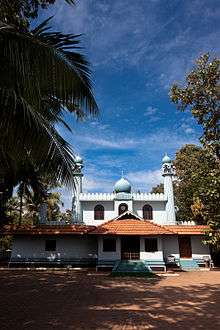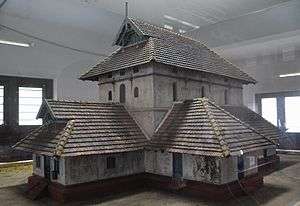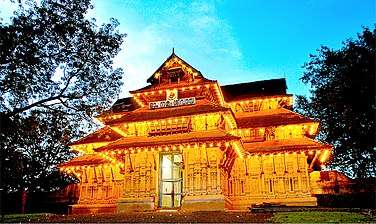Cheraman Juma Mosque
The Cheramaan Juma Mosque is a mosque in Methala, Kodungallur Taluk, Thrissur District in the Indian state of Kerala.[1][2][3] A legend claims that it was built in 629 AD,[4] which makes it the oldest mosque in the Indian subcontinent which is still in use.[5][6][7] It was built by Malik Deenar, Persian companion of the Islamic Prophet Muhammad, on the orders of the successor of Cheraman Perumal, the Chera King of modern-day Kerala.[7][8][9][10] The mosque was constructed in Kerala style with hanging lamps, making the historicity of its date claims more convincing.[7][11][12][13][14][15]
| Cheramaan Juma Mosque | |
|---|---|
 The renovated Cheramaan Juma Mosque | |
| Religion | |
| Affiliation | Islam |
| District | Thrissur |
| Location | |
| Location | Methala, Kodungalloor |
| State | Kerala |
 Shown within Kerala | |
| Territory | |
| Geographic coordinates | 10.22°N 76.194°E |
| Architecture | |
| Completed | 629 CE |
| Specifications | |
| Length | 61 m (200 ft) |
| Width | 24 m (79 ft) |
The mosque was completely destroyed by the Portuguese in 1504 when Lopo Soares de Albergaria attacked the port of Kodungallur. The old building was built some time after the 1504 de Algabaria attack (i.e., from mid-16th to the early 17th century). Modern corridors and halls were built in 1984. The 1984 extensions, which surround the old building, conceal almost all of the exterior features of the old building.[16]
History

According to some legends, Cheraman Perumal ("Cheraman Perumal" being the title held by Chera kings) witnessed the splitting of the moon, a supernatural event mentioned in the Quran[17] as a miracle performed by the Islamic Prophet Muhammad when asked for one by Meccan unbelievers. The bewildered King confirmed with his astrologers that the incident had taken place, but didn't know what to make of it. Arab merchants who had arrived at a Malabar port, a bustling global marketplace, sought audience with the King to have his permission to visit Ceylon. In conversation with them, the King learnt about Muhammad, made his son the regent of his kingdom and travelled back with the Arab merchants to meet the man himself.
The story goes that Cheraman Perumal arrived in Arabia with a gift of ginger pickles for Muhammad and his companions[18] and converted to Islam "at the feet of Prophet Muhammad".[19]
The oral traditions of the legend differ greatly, another story goes that Cheraman Perumal was visiting the King of Maldives and they discussed the splitting of the moon, both men deciding to visit Mecca to find out the truth.[19] S. N. Sadasivan, a social historian, believes that it wasn't the Cheraman Perumal of Malabar in the tale at all, but instead the King of Maldives, whose capital city "Malé" was confused for "Malabar".[20]
According to historian M.G.S. Narayanan, "there is no reason to reject the tradition that the last Chera king embraced Islam and went to Mecca, since it finds its place not only in Muslim chronicles, but also in Hindu brahmanical chronicles like the Keralolpatti, which need not be expected to concoct such a tale which in no way enhances the prestige of the Brahmins or Hindu population."[21][22]
The history of the mosque has given it many architectural quirks including that since it was a repurpose Buddhist shrine, until its reconstruction in 1000 A.D. the mosque faced East instead of towards the Kaaba. Even today the mosque still includes some remnants of the shrine, including a traditional pond and a lamp that is said to have been burning for a thousand years[23], with oil that is brought for it by visitors and pilgrims of all religions.
Location
Masjid is located in the Paravur - Kodungalloor Road, NH-66 at Kodungalloor taluk, Thrissur District in Kerala.
Ceremonies
Vidyarambham
The ceremony of Vidyarambham (Vidya means "knowledge", arambham means "beginning'), held typically on Vijayadashami, is a Hindu tradition to initiate their children into learning under the supervision of a learned person like a priest. At Cheraman Masjid, this ceremony is performed by the mosque's Muslim Imam, who traces the alphabet drawn in the sand on a child's tongue, indicating an invocation to Saraswati, the goddess of learning.
Appointment of the Aven (Priest)
The aven (priest) of Shobhaparamba Sreekurumba Bhagavati temple in Tanur, Malappuram, is appointed a member of the Pazhayakath family, a local Muslim family. According to Chellikkattil Sundaran, president of the temple trust, the temple's aven had been traditionally appointed by a member of the local Thiyya family, a Brahmin family of Pazhayakhath Ilom. The family disintegrated over the years and its remaining members converted to Islam but both the temple authorities and the family upheld the tradition. The temple's Hindu priest is appointed in a special ritual once every 12 years, presided over by a Muslim member of the Pazhayakath family, who makes the formal announcement. Locals ascribe this camaraderie to Cheraman Perumal.[19][24]
Maharajahs of Travancore
The legend of the "Makkattupoya Perumal" or "the King who went to Makkah (Mecca)" has lived on in Keralan memory and apparently, the Maharajahs of the Princedom of Travancore in pre-Independence India would say at their swearing in, "I will keep this sword until the uncle who has gone to Makkah returns".[25]
Famous Visitors
- A. P. J. Abdul Kalam, 11th President of India[26]
- Shashi Tharoor, Member of Parliament from Thiruvananthapuram, Kerala.[27]
See also
- Islam in India
- Tamil Muslim
- Muslim chronicles for Indian history
- Muziris Heritage Project
References
- "Oldest Indian mosque sets new precedent".
- "1400-year-old mosque to be restored to its original form".
- Kerala Tourism - Official Website Cheraman Juma Mosque
- Ron Geaves (2017). Islam and Britain: Muslim Mission in an Age of Empire. Bloomsbury. p. 6. ISBN 978-1-4742-7175-2.
- "Mosque in Kerala dates back to the Prophet's time".
- "Tinkering with the past".
- "INTERVIEW". www.iosworld.org. Archived from the original on 4 October 2018. Retrieved 15 November 2018.
- "Cheraman Juma Masjid: A 1,000-year-old lamp burns in this mosque".
- "Solomon To Cheraman".
- "'Cheraman Juma Masjid': The first mosque of India, built in 629".
- "Cheraman Juma Masjid: A 1,000-year-old lamp burns in this mosque".
- "Solomon To Cheraman".
- "'Cheraman Juma Masjid': The first mosque of India, built in 629".
- "Oldest Indian mosque sets new precedent".
- "1400-year-old mosque to be restored to its original form".
- Shokoohy, Mehrdad. Muslim Architecture of South India: The Sultanate of Ma'bar and the Traditions of the Maritime Settlers on the Malabar and Coromandel Coasts (Tamil Nadu, Kerala and Goa). RoutledgeCurzon, 2003. pp 139-42.
- "Surah Al-Qamar [54:1]". Surah Al-Qamar [54:1]. Retrieved 15 November 2018.
- "The Kerala king who embraced Islam". Arab News. 9 February 2012. Retrieved 15 November 2018.
- "The Syncretic Treasure of India's Oldest Mosque | Madras Courier". Madras Courier. 26 May 2017. Retrieved 15 November 2018.
- Sadasivan, S. N. (2000). A Social History of India. APH Publishing. ISBN 9788176481700.
- M. G. S., Narayanan (1996). Perumals of Kerala: Political and Social Conditions of Kerala Under the Cēra Perumals of Makotai (c. 800 A.D.-1124 A.D.). Kerala (India): Xavier Press. p. 65.
- Raṇṭattāṇi, Husain (2007). Mappila Muslims: A Study on Society and Anti Colonial Struggles. Other Books. ISBN 9788190388788.
- "Cheraman Juma Masjid: A 1,000-year-old lamp burns in this mosque - Times of India". The Times of India. Retrieved 15 November 2018.
- "Where traditions break communal divisions - Times of India". The Times of India. Retrieved 15 November 2018.
- Katz, Nathan (18 November 2000). Who Are the Jews of India?. University of California Press. ISBN 9780520213234.
- "The Hindu : Kerala News : President visits oldest mosque in sub-continent". www.thehindu.com. Retrieved 15 November 2018.
- "Shashi Tharoor on Twitter". Twitter. Retrieved 15 November 2018.
